Seleucid dynasty
The Seleucid dynasty or the Seleucidae (from Greek: Σελευκίδαι, Seleukídai) was a Macedonian Greek royal family, founded by Seleucus I Nicator, which ruled the Seleucid Empire centered in the Near East and regions of the Asian part of the earlier Achaemenid Persian Empire during the Hellenistic period.
| Seleucid dynasty | |
|---|---|
 The Vergina Sun remained a principal standard of the Seleucid dynasty, although the anchor and elephant were more prevalent. | |
| Country | Syria, Persia |
| Founded | 305 BC |
| Founder | Seleucus I |
| Final ruler | Philip II Philoromaeus |
| Titles | |
| Dissolution | 64 BC |
| Cadet branches | Diodotid dynasty (Bactria)(?) |
 |
| History of Greater Iran |
|---|
| Periods and dynasties of Babylon |
|---|
|
All years are BC |
|
See also: List of kings by Period and Dynasty |
History
Background
Seleucus (c. 358 – 281 BC) served as an officer of Alexander the Great, commanding the elite infantry corps in the Macedonian army: the "Shield-bearers" (Hypaspistai), later known as the "Silvershields" (Ἀργυράσπιδες / Argyraspides). After the death of Alexander in 323 BC, the Partition of Triparadisus assigned Seleucus as satrap of Babylon in 321 BC. Antigonus, the satrap of much of Asia Minor, forced Seleucus to flee from Babylon, but, supported by Ptolemy, the Satrap of Egypt, Seleucus returned in 312 BC. Seleucus' later conquests included Persia and Media. He formed an alliance with the Indian King Chandragupta Maurya (reigned 324-297 BC). Seleucus defeated Antigonus in the Battle of Ipsus in 301 BC and Lysimachus (King of Thrace, Macedon and Asia Minor) in the battle of Corupedium (near Sardis) in 281 BC. Ptolemy Ceraunus assassinated Seleucus later in the same year. Seleucus' eldest son Antiochus I succeeded him as ruler of the Seleucid territories.
Seleucid rulers
| Portrait | King | Reign (BC) | Consort(s) | Comments |
|---|---|---|---|---|
 | Seleucus I Nicator | Satrap 320–315, 312–305 BC King 305–281 BC | Apama | |
 | Antiochus I Soter | co-ruler from 291, ruled 281–261 BC | Stratonice of Syria | Co-ruler with his father for 10 years. |
 | Antiochus II Theos | 261–246 BC | Berenice was a daughter of Ptolemy II of Egypt. Laodice I had her and her son murdered. | |
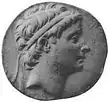 | Seleucus II Callinicus | 246–225 BC | Laodice II | |
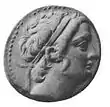 | Seleucus III Ceraunus (or Soter) | 225–223 BC | Seleucus III was assassinated by members of his army. | |
 | Antiochus III the Great | 223–187 BC |
| Antiochus III was a brother of Seleucus III. |
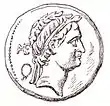 | Seleucus IV Philopator | 187–175 BC | Laodice IV | This was a brother-sister marriage. |
 | Antiochus (son of Seleucus IV) | 175–170 BC | Antiochus IV as co-ruler. | |
 | Antiochus IV Epiphanes | 175–163 BC | Laodice IV | This was a brother-sister marriage. |
| Antiochus V Eupator | 163–161 BC | |||
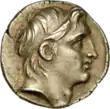 | Demetrius I Soter | 161–150 BC |
| Son of Seleucus IV Philopator and Laodice IV. |
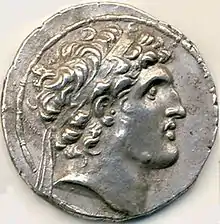 | Alexander I Balas | 150–145 BC | Cleopatra Thea | Son of Antiochus IV and Laodice IV. |
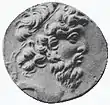 | Demetrius II Nicator | first reign, 145–138 BC | Cleopatra Thea | Son of Demetrius I. |
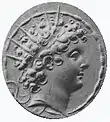 | Antiochus VI Dionysus (or Epiphanes) | 145–140 BC? | Son of Alexander Balas and Cleopatra Thea. | |
 | Diodotus Tryphon | 140–138 BC | General who was a regent for Antiochus VI Dionysus. Took the throne after murdering his charge. | |
.jpg.webp) | Antiochus VII Sidetes (or Euergetes) | 138–129 BC | Cleopatra Thea | Son of Demetrius I. |
 | Demetrius II Nicator | second reign, 129–126 BC | Cleopatra Thea | Demetrius was murdered at the instigation of his wife Cleopatra Thea. |
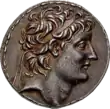 | Alexander II Zabinas | 129–123 BC | Counter-king who claimed to be an adoptive son of Antiochus VII Sidetes. | |
 | Cleopatra Thea | 126–121 BC | Daughter of Ptolemy VI of Egypt. Married to three kings: Alexander Balas, Demetrius II Nicator, and Antiochus VII Sidetes. Mother of Antiochus VI, Seleucus V, Antiochus VIII Grypus, and Antiochus IX Cyzicenus. Coregent with Antiochus VIII Grypus. | |
| Seleucus V Philometor | 126/125 BC | Murdered by his mother Cleopatra Thea. | ||
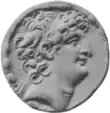 | Antiochus VIII Grypus | 125–96 BC |
| |
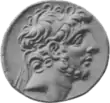 | Antiochus IX Cyzicenus | 114–96 BC | ||
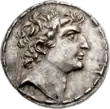 | Seleucus VI Epiphanes Nicator | 96–95 BC | ||
 | Antiochus X Eusebes Philopator | 95–92 BC or 83 BC | Cleopatra Selene I | |
 | Demetrius III Eucaerus (or Philopator) | 95–87 BC | ||
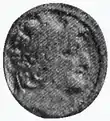 | Antiochus XI Epiphanes Philadelphus | 95–92 BCE | ||
 | Philip I Philadelphus | 95–84/83 BC | ||
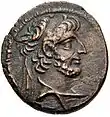 | Antiochus XII Dionysus | 87–84 BC | ||
| Cleopatra Selene or Seleucus VII | 83–69 BC | |||
 | Antiochus XIII Asiaticus | 69–64 BC | ||
| Philip II Philoromaeus | 65–63 BC |
Family tree
References
Sources
- Glanville Downey (8 December 2015). History of Antioch. Princeton University Press. pp. 735–736. ISBN 978-1-4008-7773-7.
- Mehrdad Kia (27 June 2016). The Persian Empire: A Historical Encyclopedia. ABC-CLIO. pp. 287–311. ISBN 978-1-61069-391-2.
External links
- Livius, The Seleucid Empire by Jona Lendering
